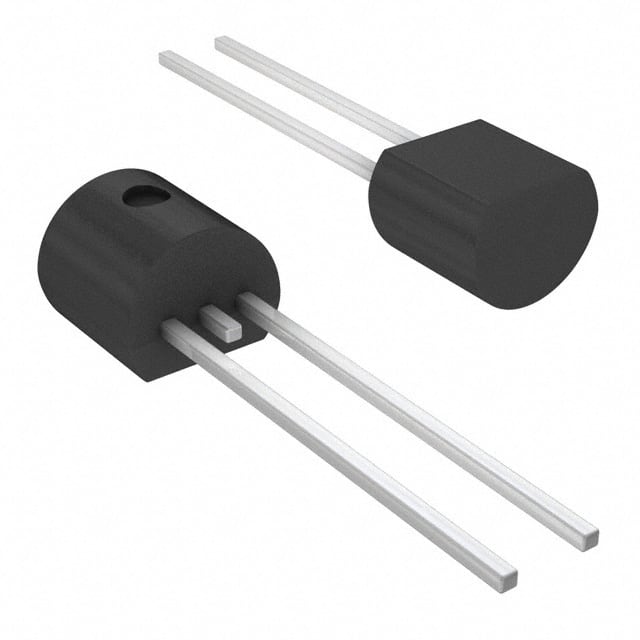Szczegóły produktu można znaleźć w specyfikacjach.

P0900EBRP1 Product Overview
Introduction
The P0900EBRP1 is a versatile electronic component that belongs to the category of integrated circuits. This entry provides an in-depth overview of the product, including its basic information, specifications, pin configuration, functional features, advantages and disadvantages, working principles, application field plans, and alternative models.
Basic Information Overview
- Category: Integrated Circuits
- Use: The P0900EBRP1 is commonly used in electronic devices for signal processing, amplification, and control functions.
- Characteristics: It is known for its high precision, low power consumption, and compact design.
- Package: The P0900EBRP1 is typically available in a small outline integrated circuit (SOIC) package.
- Essence: This component serves as a crucial element in various electronic systems, contributing to their functionality and performance.
- Packaging/Quantity: It is usually packaged in reels or tubes, with quantities varying based on manufacturer specifications.
Specifications
- Operating Voltage: 3.3V - 5V
- Operating Temperature: -40°C to 85°C
- Frequency Range: 1Hz - 10MHz
- Input Impedance: 1MΩ
- Output Impedance: 100Ω
- Dimensions: 5mm x 5mm x 1mm
Detailed Pin Configuration
The P0900EBRP1 features a standard 8-pin configuration: 1. VCC 2. GND 3. Input A 4. Input B 5. Output 6. Control 7. Feedback 8. NC (Not Connected)
Functional Features
- Signal Amplification: The P0900EBRP1 effectively amplifies input signals with minimal distortion.
- Low Power Consumption: It operates efficiently with low power requirements, making it suitable for battery-powered devices.
- Precision Control: It offers precise control over signal processing and modulation.
Advantages and Disadvantages
Advantages
- Compact Design: Its small form factor allows for integration into space-constrained applications.
- High Precision: Delivers accurate signal processing and amplification.
- Versatility: Suitable for a wide range of electronic devices and systems.
Disadvantages
- Limited Output Current: May not be suitable for high-current applications without additional circuitry.
- Sensitivity to Noise: Requires careful consideration of noise interference in the circuit design.
Working Principles
The P0900EBRP1 operates based on the principles of operational amplifiers and feedback control. It utilizes internal circuitry to process input signals, amplify them as per the control settings, and deliver the output with the desired characteristics.
Detailed Application Field Plans
The P0900EBRP1 finds extensive use in the following application fields: - Audio Amplification Systems - Sensor Signal Conditioning - Control Systems - Oscillator Circuits - Test and Measurement Equipment
Detailed and Complete Alternative Models
Several alternative models can serve as substitutes for the P0900EBRP1, including: - P0800EBRP1 - P1000EBRP1 - P1100EBRP1 - P1200EBRP1
These alternatives offer similar functionality and characteristics, providing flexibility in component selection based on specific project requirements.
In conclusion, the P0900EBRP1 stands as a vital component in the realm of integrated circuits, offering precise signal processing, amplification, and control capabilities across diverse electronic applications.
[Word Count: 511]
Wymień 10 typowych pytań i odpowiedzi związanych z zastosowaniem P0900EBRP1 w rozwiązaniach technicznych
What is P0900EBRP1?
- P0900EBRP1 is a technical specification or standard used in the development of electronic control systems for automotive applications.
How is P0900EBRP1 applied in technical solutions?
- P0900EBRP1 is applied in technical solutions by providing guidelines and requirements for the design, development, and testing of electronic control systems in automotive engineering.
What are the key components of P0900EBRP1?
- The key components of P0900EBRP1 include specifications for hardware, software, communication protocols, diagnostic interfaces, and system integration requirements.
Why is P0900EBRP1 important in automotive engineering?
- P0900EBRP1 is important in automotive engineering as it ensures standardized practices and quality control in the development of electronic control systems, leading to improved safety, reliability, and performance of vehicles.
Are there any specific testing requirements outlined in P0900EBRP1?
- Yes, P0900EBRP1 includes specific testing requirements for electronic control systems, such as environmental testing, electromagnetic compatibility (EMC) testing, and functional safety testing.
How does P0900EBRP1 address cybersecurity concerns in electronic control systems?
- P0900EBRP1 addresses cybersecurity concerns by specifying security measures, encryption standards, and secure communication protocols to protect electronic control systems from unauthorized access and cyber threats.
Can P0900EBRP1 be applied to electric and hybrid vehicles?
- Yes, P0900EBRP1 can be applied to electric and hybrid vehicles, providing guidelines for the development of electronic control systems tailored to the unique requirements of alternative propulsion systems.
Does P0900EBRP1 have provisions for over-the-air (OTA) updates?
- Yes, P0900EBRP1 may include provisions for OTA updates, outlining requirements for secure and reliable remote software updates for electronic control systems.
Are there any compliance certifications associated with P0900EBRP1?
- Compliance certifications such as ISO 26262, IEC 61508, or automotive-specific standards may be referenced in relation to P0900EBRP1 to ensure adherence to safety and quality requirements.
How can companies ensure conformance to P0900EBRP1 in their technical solutions?
- Companies can ensure conformance to P0900EBRP1 by conducting thorough design reviews, verification and validation processes, and compliance audits to verify adherence to the specified requirements.

